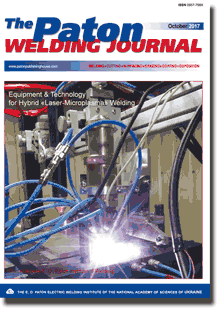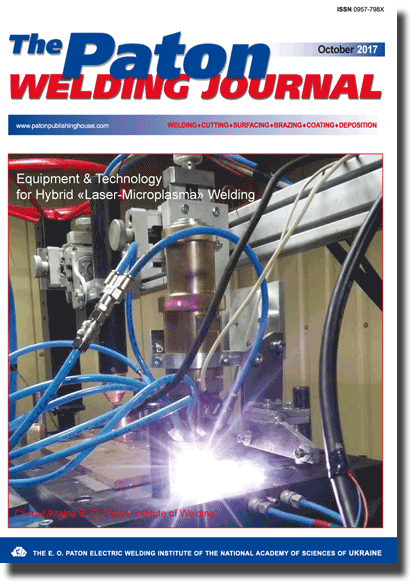| 2017 №10 (06) |
DOI of Article 10.15407/tpwj2017.10.07 |
2017 №10 (08) |

The Paton Welding Journal, 2017, #10, 43-46 pages
Sanitary-hygienic characteristic of the process of nonconsumable electrode argon-arс welding of 1201 and 1460 aluminium alloys
A.O. Lukyanenko1, T.M. Labur1, A.G. Poklyatsky1, V.A. Kuleshov1 and R.Baich. Darko2
1E.O. Paton Electric Welding Institute of the NAS of Ukraine 11 Kazimir Malevich Str., 03150, Kiev, Ukraine. E-mail: office@paton.kiev.ua
2University of Montenegro, Faculty of Mechanical Engineering, Podgorica
Abstract
The work presents the results of studying harmful substances in the air, released during nonconsumable electrode argon-arc welding of 1201 (Al–Cu–Mn) and 1460 (Al–Cu–Li) aluminium alloys. The objective of this work is performance of sanitary-hygienic assessment of the nature of aerosol and gas evolution from these alloys, in order to ensure favourable sanitary-hygienic working conditions for welders. It is shown that for 1460 alloy with lithium the intensity of welding aerosol formation is 1.5 times higher, and ozone concentration exceeds the maximum admissible concentration 3–4 times in the same welding modes. 13 Ref., 4 Tables, 5 Figures.
Keywords: aluminium-lithium alloys, nonconsumable electrode arc welding, labour safety, harmful substances, welding aerosols
Received: 06.09.17
Published: 13.11.17
References
- Ishchenko, A.Ya., Labur, T.M. (2013) Welding of modern structures from aluminium alloys. Kiev, Naukova Dumka [in Russian].
- Levchenko, O.G. (2015) Welding aerosols and gases: Processes of formation, methods of neutralization and protection facilities. Kiev, Naukova Dumka [in Russian].
- Levchenko, O.G., Lukyanenko, A.O., Polukarov, Yu.O. (2011) Concentration of carbon oxide and nitrogen dioxide in air of a working zone in covered-electrode welding. The Paton Welding J., 1, 32–35 [in Russian].
- Levchenko, O.G., Maksimov, S.Yu., Lukyanenko, A.O. et al. (2015) Comparative hygienic evaluation of arc welding process at constant and pulsed electrode wire feed. Ibid., 12, 39–44 [in Russian].
- (1999) GOST 4784–97: Aluminium and aluminium wrought alloys. Grades. In: Interstate council on standardization, metrology and certification. Minsk [in Russian].
- Nekrasov, B.V. (1970) Fundamentals of general chemistry. Vol. 3. Moscow, Khimiya [in Russian].
- Minzdrav SSSR (1978) MU 1924–78: Hygienic evaluation of welding materials and methods of welding, surfacing and cutting of metals. Procedural guidelines [in Russian].
- Minzdrav SSSR (1988) MU 4945–88: Procedural guidelines on determination of harmful substances in welding aerosol (solid phase and gases). Moscow [in Russian].
- GOST 12.0.003–74: SSBT. Dangerous and harmful production factors. Classification. Moscow, Standart [in Russian].
- Levchenko, O.G. (2010) Labour protection in welding production: Manual. Kyiv, Osnova [in Ukrainian].
- (1988) GOST 12.1.005–88: SSBT. General sanitary-hygienic requirements to air of working zone. Moscow, Gosstandart SSSR [in Russian].
- Erokhin, A.A. (1973) Fundamentals of fusion welding: Physical-chemical principles. Moscow, Mashinostroenie [in Russian].
- Pattee, H.E., Mayers. L.B., Evans, R.M. et al. (1973) Effects of arc radiation and heat on welders. Welding J., 52, 297–308.
Suggested Citation
A.O. Lukyanenko, T.M. Labur, A.G. Poklyatsky, V.A. Kuleshov and R.Baich. Darko (2017) Sanitary-hygienic characteristic of the process of nonconsumable electrode argon-arс welding of 1201 and 1460 aluminium alloys. The Paton Welding J., 10, 43-46.The cost of subscription/purchase order journals or individual articles
| Journal/Currency | Annual Set | 1 issue printed |
1 issue |
one article |
| TPWJ/USD | 384 $ | 32 $ | 26 $ | 13 $ |
| TPWJ/EUR | 348 € | 29 € | 24 € | 12 € |
| TPWJ/UAH | 7200 UAH | 600 UAH | 600 UAH | 280 UAH |
| AS/UAH | 1800 UAH | 300 UAH | 300 UAH | 150 UAH |
| AS/USD | 192 $ | 32 $ | 26 $ | 13 $ |
| AS/EUR | 180 € | 30 € | 25 € | 12 € |
| SEM/UAH | 1200 UAH | 300 UAH | 300 UAH | 150 UAH |
| SEM/USD | 128 $ | 32 $ | 26 $ | 13 $ |
| SEM/EUR | 120 € | 30 € | 25 € | 12 € |
| TDNK/UAH | 1200 UAH | 300 UAH | 300 UAH | 150 UAH |
| TDNK/USD | 128 $ | 32 $ | 26 $ | 13 $ |
| TDNK/EUR | 120 € | 30 € | 25 € | 15 € |
AS = «Automatic Welding» - 6 issues per year;
TPWJ = «PATON WELDING JOURNAL» - 12 issues per year;
SEM = «Electrometallurgy Today» - 4 issues per year;
TDNK = «Technical Diagnostics and Non-Destructive Testing» - 4 issues per year.


